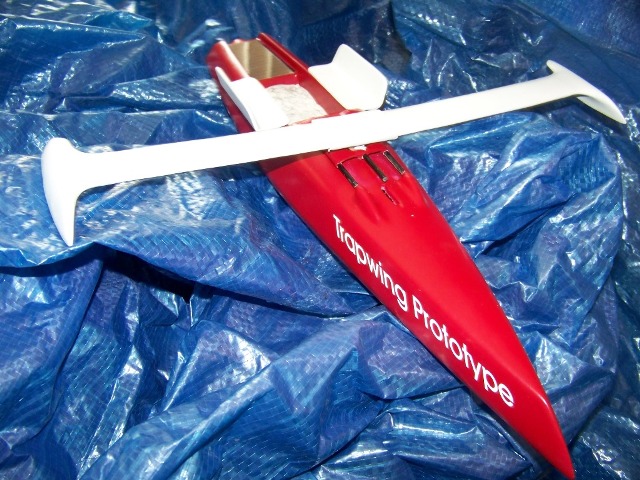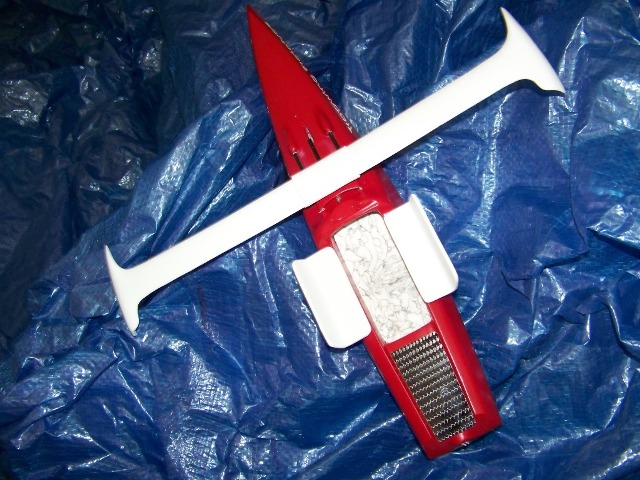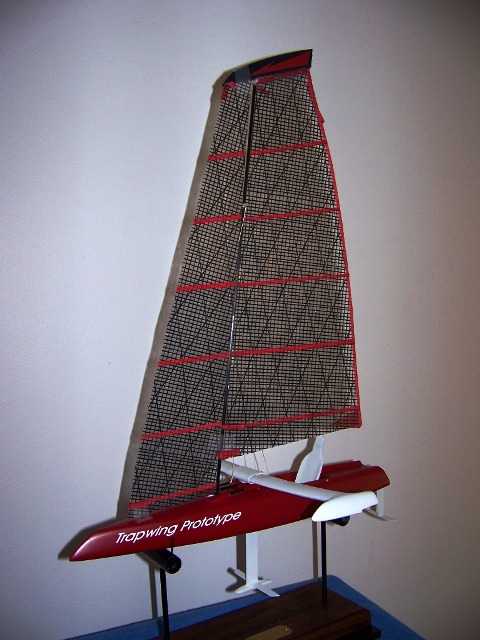This is a unique design that uses ballast in a sealed wing in several different versions.
Yes, there are numbers and yes there are pictures of a model of the prototype, cause that's how I roll.
Here are some details:
-----------
Trapwing Prototype: LOA 17' 8"(5.38m) Beam hull-3.25'(1 m) overall 12'(3.66m)(subject to testing) Weight- hull 155lb ballast-wing 80lb(36.3kg)-180lb(81.8kg)(variable and subject to testing) keel 0-80lb(36.3kg)(subject to testing)dinghy version-no keel. SA-upwind 100sq.ft(9.3sq.m)-180sq.ft(16.7 sq.m) variable downwind 200sq.ft(18.6sq.m)-360sq.ft(33.46sq.m). (variable and subject to testing) crew-singlehanded-120lb(54.5kg)-220lb(100kg) (variable and equalized under class rules- subject to testing) crew position for racing on the centerline inside boat, fixed athwhartships, variable fore and aft

--------------------
1) Sail area to be between 100sq.ft(9.3sq.m) and 180 sq.ft(16.7 sq.m) a-different rigs b-different amounts of ballast
2) Ballast wing to be supported by trapeze wires and unique retention system that allows wing and ballast to slide simultaneously, allows athwhartship pivoting and fore and aft movement. a-version one will use two aluminum tubes with sliding external tray- the tubes and tray move simulataneously: -attachment system allows wing- with weight centered-to be levered up and then pivoted from a position 90 degrees to the CL to a position parallel to the centerline for transport and stowage. -weight can be added or removed in small increments. -fore and aft pivot/sliding tube is mounted to the boat slightly offset from the CL to allow room to retract board/keel. -aluminum tubes terminate at outboard ends in buoyancy pods-pods will be changeable as determined in testing. -sliding ballast tray and structural design of wing to be capable of 180lb(81.8kg) max ballast @9'(2.5m) from CL; ballast completely adjustable in the range of 80(36.3kg) to 180lb(81.8kg).
b-version two is a slightly curved(athwhartship), molded and sealed(with sealable access to ballast tray) wing with an internal sliding ballast tray. This version will be the final version and incorporates all the features of version one with significantly increased sealed buoyancy. c-Wing movement by manual or electric means. Minimum electrical movement speed 4' per second. Minimum electrical "stamina" on single battery-12 hours at a rate equivalent to a approximately 60 (full track)tacks per hour. Now I know that this is illegal based on current US Sailing rules, but rules are for wimps.
------
3) Crew Position a-version one-racing position-allows crew to sit in an extremely comfortable seat that is fixed athwhartship and slides fore and aft adjustably while sailing. -extremely wide crew weight range:for racing lower tray attached to seat may contain ballast used to equalize crew weight in the range of 120lb.(54.5kg) to 220lb.(100kg) -seat may be moved manually or electrically. b-version two-center seat is removed and two fixed carbon seats with backrests are "plugged-in" to each side deck.
-- 4) Rigs to be tested are main and jib, main alone, jib alone, with and without an asymetrical spinnaker and no sails at all. a-asymetrical will be tested as permanently mounted off a bowsprit(a la Weta tri) or retracted into a trough with roller(a la Viper) and a retractable pole (a la the local strip club). b-mast to be sealed with masthead floatation in an endplate configuration. Some buoyancy possible in head of sail.
-- 5)-Daggerboard/ keel/rudder a -boat will be tested with and without a retractable "lifting keel" which would essentially be a carbon daggerboard with the minimum ballast required(determined in testing) to right the boat from a pitchpole(where the wing buoyancy may not significantly help). b-self-righting from a knockdown or pitchpole is a required design element for any version of the boat used for disabled sailing.

c-a turbo version of the boat will not use a ballasted keel and may not be suitable for disabled sailing but this will be determined in testing. d- the daggerboard may include as standard a lifting hydrofoil designed to provide "foil-assist" to reduce wetted surface and in conjunction with the rudder hydrofoil improve the pitch and planing characterstics of the boat. e-a fully flying hydrofoil system will be tested as will a fully flying system that allows the boat to fly downwind only(requiring less upwind SA and less ballast). f-rudder will be retractable with a t-foil, and a j-foil or is it a k-bulb, or an f-boat I forget, no wait it's a c-cat.
6)-On the Beach a-the boat will be able to be easily beach sailed with a dolly incorporated into the trailer design to make it very simple to go from trailer to water. A "power assist" dolly may be available, this 20' crane can also be used to park your car if required.

7)-Performance a- the goal is to develop a high performance planing sailboat that can be safely sailed from a center crew position by disabled or able-bodied sailors. I am hoping to be able to achieve an SCP/total weight of 30% or slightly better though that is just a target and a less powerfull version with numbers and performance more like a Windmill or Tasar, or Optimist may be perfectly acceptable. The use of foil-assist technology will help to achieve the performance goals, or make the boat as slow as molasses, Full flying foiling is possible in a selfrighting boat-particularly one with the righting assist this boat has from version two of THE Wing. This wing was licensed to Larry for his little trimaran that he sailed off the coast of spain.
The concept has extraordinary potential and it will be a blast finding out just what she'll do. Now I just need to find the remote control.
